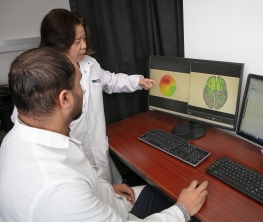Core Research Areas
The Biomarker and Neuro-disease Mechanism Laboratory, led by Alfred Fonteh, examines lipid biomarkers found in urine and plasma. Together with postdoctoral fellow Joby Jose, PhD, they explore the correlation between energy-related and oxidatively derived short-chain and medium-chain lipids in cognitively healthy (CH), Mild Cognitive Impairment (MCI), and Alzheimer’s disease (AD) subjects. Additionally, they are investigating the fluctuations of brain-derived lipids in subjects at various stages of Alzheimer’s disease. Other significant studies include the correlation between bioenergetics and mitochondrial dysfunction and disturbances in the neuromodulator pathways associated with Alzheimer’s disease.
Cognitive Function and Network Biomarkers
The Cognition and Brain Integration Laboratory, led by Xianghong Arakaki, MD, PhD, studies cognitive changes in asymptomatic or early-stage AD subjects. Using data from Electroencephalogram (EEG) studies and functional near-infrared spectroscopy (fNIRS), Dr. Arakaki and postdoctoral fellow Abdulhakim Al-Ezzi examine differences in cognitive connectivity and functional changes in the brain among people with low and high risk of developing AD. Researchers are focused on developing novel neurophysiological biomarkers to characterize pre-symptomatic AD, with the aim of improving early detection and predicting symptom onset. This approach provides rich data for systems biology modeling in AD research and other neurological diseases.
Stroke Neuroprotection
Vascular brain injury, such as from stroke, is a significant comorbid condition with neurodegenerative disease, including Alzheimer’s disease, and exacerbation of either condition may accelerate pathology and symptom onset overall. Despite decades of prevention efforts, stroke is a major cause of morbidity and mortality – every 40 seconds, someone in the US has a stroke, affecting more than 795,000 annually. HMRI’s cardiovascular researchers are examining emerging evidence from animal studies suggesting that sodium-glucose co-transporter 2 (SGLT2) inhibitors, licensed for the treatment of type 2 diabetes mellitus, may also have neuroprotective effects.
Stroke Model
As part of the commitment to studying the heart-brain connection, and especially the influence of stroke and vascular injury on subsequent risk of neuronal death and neurodegenerative diseases, researchers have developed a model for examining stroke and subsequent changes in brain oxygenation and blood flow in vivo. This EEG-based model, combined with real-time laser doppler flowmetry (LDF), measures brain oxygenation levels, enables real-time monitoring of brain activity during and after stroke, and the examination of associations with heart rate variability (HRV) and heart rate fragmentation (HRF).
Retinal Scan Biomarkers
Collaborators with HMRI investigators continue their ongoing work with the data collection of retinal scans among people with varying levels of Alzheimer’s disease biomarkers (ptau217, total tau, ptau231, ptau181). In a preliminary analysis, researchers detected a correlation between retinal thinning and neurodegeneration in early Alzheimer’s disease.





